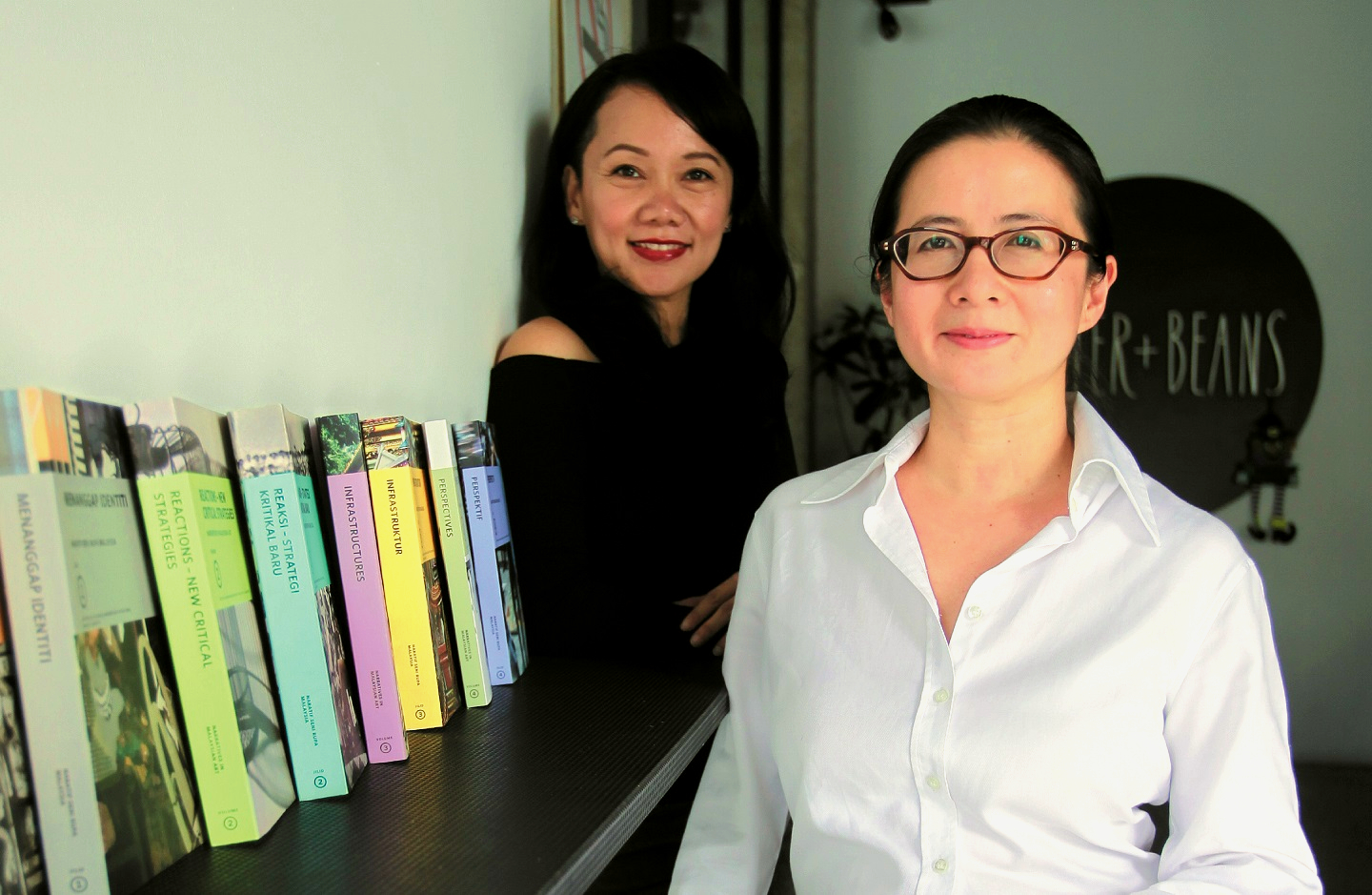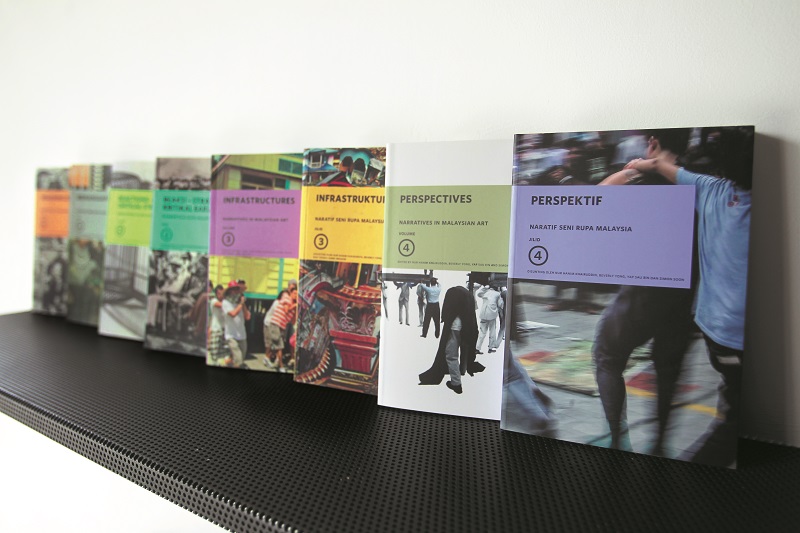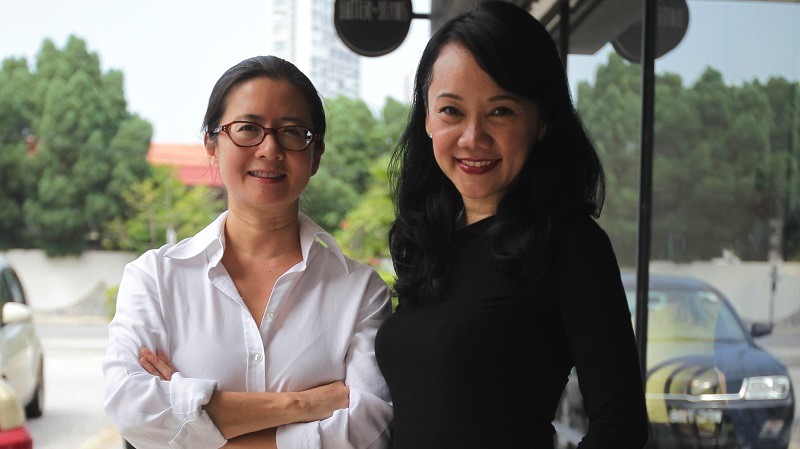
Rachel Ng (left) and Beverly Yong published volume one in 2012 (All photos: Suhaimi Yusuf/The Edge)
Beverly Yong and Rachel Ng rounded the corner from their nearby office into the Butter + Beans café in Petaling Jaya to meet us with easy smiles. After all, the co-founders of RogueArt, well known within the Southeast Asian fine art circles for their accomplishments as curators, gallerists, art writers and consultants, both collectively and individually, have finally completed their four-volume series, Narratives in Malaysian Art, which they embarked upon 10 years ago.
Having worked together in the late 1990s and early 2000s at Valentine Willie Fine Art — a leading Malaysian gallery that had offshoots in Singapore, Jogjakarta and Manila before its founder retired from the commercial art market and closed its gallery doors a few years ago — Yong and Ng decided in 2008 that it was time to leave and shift their focus onto the “big picture” things of art, along with fellow co-founder Adeline Ooi, who has since gone on to helm Art Basel Hong Kong as director.
“It’s always been our interest to stir conversation and to delve into things like art infrastructure, development, writing,” says Ng, whose background is in art management.
“As gallerists, we were doing a lot of these things already, on top of the 28 exhibitions we had to run in a year. So, we figured we might as well switch and do this full-time,” Yong chimes in, explaining the start of RogueArt.
Officially, the duo are art consultants and project managers, helping clients or collaborators create, develop and implement strategic ideas and programmes.
The book series, however, offers a glimpse into what Yong and Ng are truly passionate about, that is to bring voices together — be it artists, academics, organisations, institutions and state. Narratives in Malaysian Art was conceived in that manner, a bilingual English and Bahasa Malaysia collaborative effort helmed editorially by Yong and her co-editor-in-chief, Nur Hanim Khairuddin, a fellow curator and art writer. Each volume features a roundtable discussion with guest editors, writers, contributors and advisers, underlining what made Yong and Ng want to start the project in the first place.
20191107_pro_book_by_yong_rachel_2_sy.jpg

“I think it started off as a feeling among many people that we needed to have more criticism, more art writing,” says Yong, who adds that they only decided the ultimate course after discussions with the initial editors of volumes one and two, artist-academic Hasnul J Saidon, artist Anurendra Jegadeva, communications specialist Eva McGovern and art historian-curator TK Sabapathy, who was consultant editor.
Volumes one and two home in on art itself, specifically Malaysian art history and artistic strategies. In the first, Yong and Nur Hanim juxtaposed existing and new writings, with contributors offering their own perspectives and responses on seminal art historical texts by the likes of famed art critics and historians Redza Piyadasa and Sulaiman Esa.
“We wanted to create a conversation between old writing and new writing,” says Yong.
The second volume, Reactions — New Critical Strategies, traces Malaysian artists and their works in thematic examinations, focusing particularly on the 1970s to current day. Interspersed with essays exploring broader topics, selected artworks were looked at through oral interviews, catalogues of art exhibitions and artist’s statements, delving into their political, social, and even environmental connotations and more. An example would be Wong Hoy Cheong’s performance and installation work, Lalang (1994), which comments on the notorious Operation Lalang Special Branch crackdown in 1987, or Zulkifli Yusoff’s Power 1, on the idea of authority and its abuse, and Anurendra Jegadeva’s Running Indians and the History of Malaysian Indians in 25 Clichés.
For the third and fourth books, Yong and Ng say they stepped out to look at the broader picture. “We cast the net wider, to look at what allows artmaking to happen,” notes Ng. More of a practical guide, Infrastructures is about the Malaysian art ecosystem — the “scene”, so to speak — and covers institutions, the art market, art education, art initiatives and writing and publication.
“We even created actual maps,” adds Ng. These include maps of commercial galleries, art institutions, artist-run spaces and art schools within the country. “We got [multimedia artist] Yap Sau Bin to come in and help with this, so that people can actually pick up the book and physically go around using the maps.”
Yong nods, pointing out that it was also a good opportunity to highlight the increasing art-related infrastructures and events outside of Kuala Lumpur.
yong_and_ng.jpg

Recounting the recent release of the final volume, Perspectives, a full decade after the project was conceived, Yong and Ng acknowledge that the exercise has in its own way, come full circle. “For this, Yap and (art academic) Simon Soon came on board as editors,” shares Yong. In a segment about the art of art writing itself, Soon invited four to five writers to look at the parts and ways in which the first three books had missed out on in their coverage of Malaysian art.
“One of them is (US artist and art academic) Ray Langenbach. He critiqued the series as a whole, what’s missing, what’s wrong, and he came up with an essay about inclusion and exclusion —on who writes these narratives. He also wrote on the history of performance art, about the queer and expatriate elements that are often hidden in the writing of our history,” Yong says.
Perspectives also moves the focus towards the future, of questioning “how do we go forward?” Yap looked at curating as an invisible hand that shapes how we see art, while the issues of censorship, art for building communities and for social change are also touched upon in a section on art and the public. In this, a survey was also done of Malaysians of all generations and backgrounds, to get their views on the usefulness of art.
“We asked what people thought about art in schools, how the government can offer support towards art and even artists they can name. What we got back was refreshing, to say the least. At the same time, we also highlighted conversations with figures at the intersection between the public and the art industry …” says Yong, citing Uncle Rajah, a long-time gallery assistant at the National Art Gallery as an example. “So many people remember him; he’s been there for over 30 years. And he continues to be very passionate about the importance of a gallery, public ownership and the role of the artist.”
The books may be done, but the chapter is not closed. Commenting on the response to the series, Yong and Ng say there have been some surprises. For one, copies of the book they thought to be most unlikely to sell out, Infrastructures, have all been snapped up. “There’re still some in the BM version though,” Ng notes quickly.
They are also happy to hear about people who have read the books and are now interested in art writing and Malaysian art history. Having fundraised for the project in 2009 in a roadshow called Talking the Walk, the duo are now looking at going out again with another series of conversations and discussions about key topics from Narratives, this time calling it Walking the Talk.
“This particular project is done, but not the larger one of boosting more art documentation and critiquing. We just hope this has helped a bit as a resource,” Yong concludes.
'The Narratives in Malaysian Art' series is available at Gerak Budaya bookstore.
This article first appeared on Nov 25, 2019 in The Edge Malaysia.


